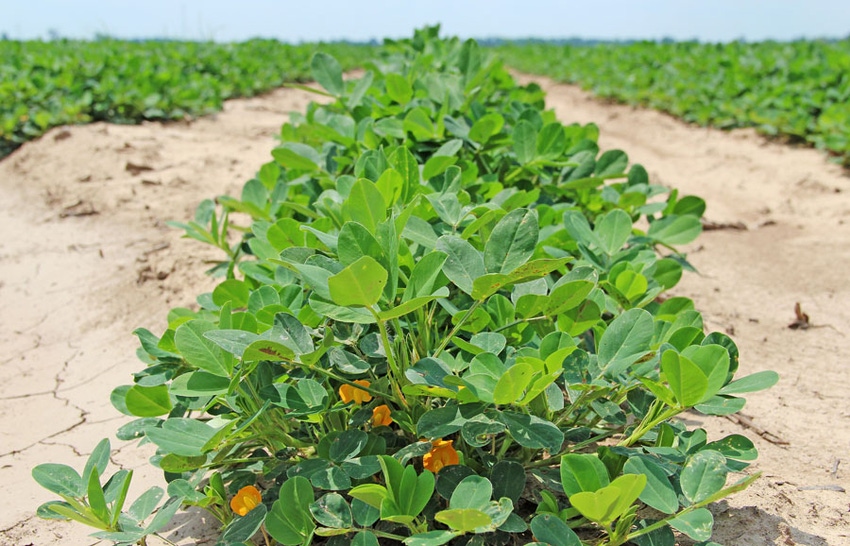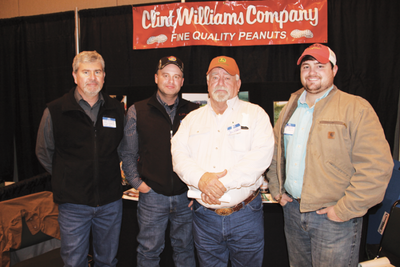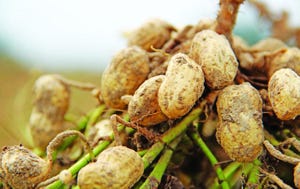
While peanut plants can absorb calcium from the soil, “They can’t translocate it down into the developing nuts — that’s why it’s important that the calcium has to be available in the top three inches of the soil," says Glen Harris, University of Georgia Extension fertility specialist.

If developing peanuts aren’t getting the calcium they need — in the pegging zone, where it really matters — yield and quality can suffer, says Glen Harris.
And an important step in providing that calcium, he said at the annual meeting of the Mississippi Peanut Growers Association, is soil sampling to determine what’s there and how much more may be needed.
Harris, University of Georgia-Tifton Extension professor of crop and soil sciences, notes that while peanut plants can absorb calcium from the soil, “They can’t translocate it down into the developing nuts — that’s why it’s important that the calcium has to be available in the top three inches of the soil.

CLINT WILLIAMS COMPANY personnel attending the annual meeting of the Mississippi Peanut Growers Association were, from left, Jeff Sharrock, Madill, Okla.; Brian Wilson and Zack Killebrew, and Jon Byrd, all at Greenwood, Miss.
“We recommend soil sampling to a three-inch depth, close to the plants after they’ve come up, to determine the calcium level and calcium/potassium ratio.”
Why is calcium so important to peanut development? “If there isn’t enough in the pegging zone to be absorbed into the nuts, you’ll get ‘pops’ (no nuts developing in the shell), pod rot, black heart, and poor germination,” Harris says.
Further, “If you’re producing peanuts for seed to plant the next year, calcium is critical for optimum germination of those seed. Research has shown there’s a very strong relationship between seed calcium level and germination. For a bare minimum 85 percent germination, you need 200 parts per million (ppm) to 300 ppm in the peanuts. But for really good germination — seed companies shoot for 95 percent or better — you need 500 ppm to 600 ppm in the seed.”
Harris worked extensively with cotton fertility before shifting more toward peanuts in 2008, when a major switch was under way from small-seeded varieties such as Georgia Green to large-seed varieties such as Georgia 06G.
More calcium for larger-seeded varieties?
“The question growers wanted answered was, is more calcium needed for these larger-seeded varieties? The prevailing logic was that the larger the peanut size, the more calcium that’s needed. Our research, using gypsum, focused on the impact of calcium rate.
“At that time, our recommendation was for at least 500 pounds of soil test calcium in the pegging zone. If you didn’t have that much, the recommendation was for 1,000 pounds of gypsum on runner peanuts. For Virginia peanuts, which have large seed, everyone made an automatic 2,000 pound gypsum application.”
With the new large-seeded runner varieties, Harris says, “We thought maybe instead of 500 pounds of soil test calcium, they might need 750 pounds in the pegging zone. And if we didn’t have at least that much, then we’d pump the gypsum application up to 1,500 pounds.”

RYAN NOBLES, from left, Hattiesburg, Miss.; Van Hensarling and Jerid Hensarling, Richton, Miss.; and Joe Morgan, Jr., during a break at the annual Mississippi Peanut Growers Association conference
But, he says, “It’s a good thing we did the research, because that theory didn’t pan out. We found that it wasn’t necessary to increase our gypsum recommendation for the large-seeded varieties.”
For many crops, Harris notes, “We tend to focus on the Big Three nutrients: nitrogen, phosphorous, and potassium. As a legume, peanuts fix nitrogen and they are a very good scavenger of phosphorus and potassium. But, it is very important that we provide the needed calcium.
“Peanuts are also a pretty good scavenger of magnesium from the soil, as well as sulfur. Magnesium is usually supplied from dolomitic lime, although we’ve been moving away from that form to calcitic lime. If you apply gypsum, which is calcium sulfate, you’re applying sulfur, too.”
Peanuts don’t require large amounts of micronutrients, Harris says. “There are three we usually focus on. Boron is usually minimal in the soil, so we recommend a foliar spray — and it’s cheap.
“The other two, manganese and zinc, are very much tied to soil pH, but in providing these we need to watch out for manganese deficiency and zinc toxicity.”
EAT MORE PEANUTS: Harvard study documents health benefits
There are a number of different gypsum products that can be used to get calcium into the pegging zone, he says. “A lot depends on which source you use, how you put it out, and the timing.”
Another option is lime, which is available in several forms, “but it needs to be used correctly,” Harris says. “Many producers think they have to use fine ground, high calcium lime, but that’s not the case — regular ground dolomitic lime will work fine, as long as you put it out correctly.”
There are liquid calciums, too, he notes, “But you need to be careful and know how to use whichever product you select.
There are also liquid limes and liquid gypsums, with various suspensions, but there can be handling issues with these that you need to be aware of.
“There are also some foliar products, but although peanuts will take up calcium through the leaves, they don’t move it down into the developing nuts, so spraying calcium on foliage isn’t going to help.
Availability, cost, handling considerations
“If you have adequate calcium sulfate, most of these products are very effective, and you can base your choice on availability, cost, handling, etc. As for the gypsums, I’ve not seen a bad one yet.”
For timing of gypsum applications, Harris says, “Our recommendation is to apply gypsum at early bloom, about 35 days after planting. If you’re applying calcium chloride or calcium thiosulfate through a center pivot, this should be done 60 to 90 days after planting.”
Solubility of calcium in the various products is key, he says. “The reason we apply lime at planting is because the calcium carbonate in lime is less soluble than the calcium in gypsum, which in turn is less soluble than the liquids.
“So, we apply lime at planting to give it enough time to become soluble. If you apply it at bloom time, it’s too late; so we apply gypsum, which is more soluble. If for some reason you need to add some more calcium at the 60-90 day period, you can use one of the liquid products.”
Research trials have shown, Harris says, that lime recommendations should differ for dryland and irrigated peanuts. “We were recommending lime at planting for both dryland and irrigated peanuts. But our research data showed lime at planting, in a normal year, does not perform as well as gypsum for dryland peanuts. So, one of our new recommendations for dryland peanuts is to use gypsum at bloom time, not lime.
“And we’ve found that adding calcium chloride in irrigation water is not as effective as gypsum — but it will get some calcium into the peanuts.
“There’s a new liquid lime we tested for the first time last year, which should work well in center pivot applications. It raised pH very quickly and held it, and we’re going to be studying how effective it is at getting get calcium into the nuts.”
Watch pH to avoid zinc/aluminum toxicity
Soil pH and calcium are usually related, Harris says, and “this is super-critical with peanuts. Once you get to 5.5 pH, aluminum becomes available, but with pH below 5.5 aluminum becomes toxic to most plants, including peanuts. Zinc is also very toxic at that level, and peanuts are very sensitive to zinc toxicity. Unless you bring the pH up, there’s not much you can do in these situations.
“Luckily, we have soil test guidelines that show which pH levels are needed to offset zinc toxicity. For example, if you have a soil test zinc level of 10, a pH level of 6.1 to 6.2 should avoid toxicity. There are correlations between various pH levels and zinc levels to avoid toxicity.”
High oleic peanuts: An opportunity for some growers?
Zinc can be a concern in using chicken litter on peanuts, Harris says. “There is about 1/2 pound of zinc per ton of chicken litter. While we don’t recommend applying chicken litter directly on peanuts, it does contain some calcium carbonate that will help maintain pH. It also has a lot of phosphorus, which interacts with zinc and helps keep down toxicity. We’ve not seen as many issues with zinc toxicity with chicken litter as we had expected, and as long as you keep the pH and zinc levels in balance, it shouldn’t be a problem.”
One possible issue, Harris says: “If you raise your pH too high to offset zinc toxicity, you could create a manganese deficiency. We see this fairly often — yellowing between veins is a symptom. If you bring your pH up enough to tie up the zinc, you’re also tying up the manganese.”
“If you have a a pH of 6.0, you need at least 8 pounds to 10 pounds of soil test manganese to avoid deficiency; for a pH of 7.0, you need around 15 pounds of manganese.”
About the Author(s)
You May Also Like



